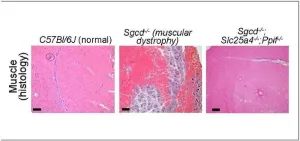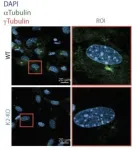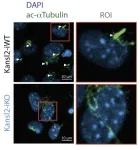(Press-News.org) Ever since the Jerry Lewis telethons began in the 1960s, millions of people have become familiar with an otherwise rare disease called muscular dystrophy (MD).
The medical world has learned much over the ensuing years, including that more than 30 closely related disorders exist that can produce the gradual muscle degeneration that steals a child’s ability to walk and eventually disrupts other organ functions. An estimated 250,000 people in the U.S. are living with a muscular dystrophy. While many are living longer lives thanks to improved treatments, no cure has been found.
Now an eye-opening study led by scientists at Cincinnati Children’s--published Aug. 25, 2023, in Science Advances--reports an entirely new approach to preventing the muscle-wasting symptoms of MD. The research focuses on the role played by mitochondria, the tiny organelle within our cells that processes nutrients into the energy cells need to survive.
“We have isolated the primary disease-causing component of muscular dystrophy to the mitochondrial permeability pore,” says the study’s corresponding author Jeffery Molkentin, PhD. “If we prevent this pore from functioning, dystrophic disease in the mouse models we studied almost completely vanishes. We see the protection lasting past one year of life in the mouse, which translates to about 40 years of life for a human.”
Molkentin is a widely respected expert in the basic science of muscle cell function and formation. He is co-executive director of the Heart Institute at Cincinnati Children’s and director of its Division of Cardiovascular Biology. He has studied muscular dystrophies for over 20 years.
Molkentin cautions that this discovery was achieved by observing outcomes in mice that were genetically modified to lack two genes that control mitochondrial permeability transition pore (MPTP) formation. Much more research beyond this early success will be needed to develop a safe and effective treatment for people with MDs.
Mitochondria take center stage
Mitochondria organelles are surrounded by their own membrane. However, when exposed to oxidative stress or a pathologic overload of calcium ions (Ca2+) mitochondria open a pore in their protective membrane. The influx of excess calcium causes the organelle to burst, which in turn causes muscle fibers to die, eventually leading to wasting of entire muscle groups.
This process of mitochondrial pore-regulated cell death has been observed in other conditions including heart muscle damage after heart attacks and neurodegenerative diseases including Huntington’s disease, Alzheimer’s disease, and amyotrophic lateral sclerosis (ALS).
In this study, Molkentin and colleagues reveal the mechanisms at work when this mitochondria-destroying process occurs in MDs. The team determined that two genes in mice—Slc25a4 and Ppif—work in concert to mediate unwanted pore formation. Controlling either one by themselves only slowed MD progression, but the absence of both together stopped it.
“We found direct evidence that these genes produce required components that govern cell death, which opens a previously unrecognized pathway for potentially treating MDs and other necrotic diseases,” Molkentin says.
Challenges ahead
Developing a medication to protect mitochondria in muscle cells will require much more study, Molkentin says.
The mouse gene Ppif produces a protein called CypD. Researchers established years ago that the immune-suppressing drug cyclosporin A can block this protein, but long-term use of the drug at high doses poses significant risk of side effects. In MD, the drug only mildly slows the disease in animal models.
Meanwhile, the mouse gene Slc25a4 encodes a protein called ANT1. There are no medications that target this protein. The existing compounds known to bind with this protein are fatally toxic, so new compounds would be needed.
“If a nontoxic ANT inhibitor can be identified, that also can target the mitochondrial pore, our results suggest that combined treatment with low dosages of a CypD inhibitor could be a novel therapeutic strategy,” Molkentin says. “Such a treatment could provide benefits independently or in combination with other gene therapies.”
Would such a treatment “cure” muscular dystrophy? It’s too soon to say. This study focused exclusively on skeletal muscle. More research would be needed to determine if the mitochondria-protecting approach also would protect against MD-related heart damage or other organ dysfunctions.
About this study
In addition to Molkentin, Cincinnati Children’s researchers involved in this study included first author Michael Bround, PhD, and co-authors Julian Havens, BS, Allen York, BS, and Michelle Sargent, BS. Jason Karch, PhD, from Baylor College of Medicine also was a co-author.
Funding sources included the National Heart, Lung, and Blood Institutes (R01HL132831 and R01HL150031), the National Institute of Arthritis and Musculoskeletal and Skin Diseases (K99AR078253), the L. B. Research and Education Foundation, and the Leducq Foundation.
About Cincinnati Children’s
Cincinnati Children’s is a nonprofit, comprehensive pediatric health system. As a leader in research, education, patient care, advocacy and innovation, Cincinnati Children’s is ranked #1 in U.S. News & World Report’s 2023-2024 list of best children’s hospitals in the nation and is the #2 recipient of pediatric research grants from the National Institutes of Health. Cincinnati Children’s is internationally recognized for improving child health and transforming delivery of care.
END
Mitochondria pore emerges as potential key to managing muscular dystrophies
Cincinnati Children’s scientists discover how damage to the cell’s energy factory triggers muscle wasting outcomes. In gene-edited mice, closing a pore in the mitochondrial membrane stops disease progression
2023-08-25
ELSE PRESS RELEASES FROM THIS DATE:
Unlocking the secrets of cell antennas
2023-08-25
Cilia are thin, eyelash-like extensions on the surface of cells. They perform a wide variety of functions, acting as mechanosensors or chemosensors, and play a crucial role in many signaling pathways. In the last few decades, the organelle has undergone a remarkable, but at the same time sinister, career transformation. It evolved from an organelle whose relevance was unclear to becoming a central player in the pathogenesis of a large group of diseases. These so-called ciliopathies are associated with a wide range of symptoms, including hearing loss, visual impairment, obesity, kidney disease, and mental disability. Different gene mutations impair cilia formation, ...
How origami might inform disease diagnoses
2023-08-25
Researchers at the USC Viterbi School of Engineering looked to origami to create new sensors that could someday be employed to detect deformations in organs and also for use in wearables and soft robotics.
Their paper, “High-Stretchability and Low-Hysteresis Strain Sensors Using Origami-Inspired 3D Mesostructures,” featured in Science Advances explains how USC researchers Hangbo Zhao, Xinghao Huang, Liangshu Liu, Yung Hsin Lin, Rui Feng, Yiyang Shen, and Yuanning Chang developed “stretchable strain sensors,” ...
Weight loss medication benefits patients with heart failure and obesity
2023-08-25
Amsterdam, Netherlands – 25 Aug 2023: Semaglutide improves heart failure-related symptoms and physical function and results in greater weight loss compared with placebo in patients with heart failure with preserved ejection fraction (HFpEF) and obesity, according to late breaking research presented in a Hot Line session today at ESC Congress 2023.1
Approximately half of patients with heart failure in the community have HFpEF.2 Most patients with HFpEF are overweight or obese, and growing evidence suggests that obesity and excess adiposity are not simply comorbidities, ...
Oral anticoagulation is not effective in patients with atrial high-rate episodes
2023-08-25
Amsterdam, Netherlands – 25 Aug 2023: Blood thinners (anticoagulants) cause bleeding without preventing stroke in patients with atrial high rate episodes (AHRE), but without electrocardiogram (ECG)-diagnosed atrial fibrillation, according to late breaking research presented in a Hot Line session today at ESC Congress 2023 and simultaneously published in the New England Journal of Medicine.1
Anticoagulants prevent strokes in patients with atrial fibrillation but are not effective in those without atrial fibrillation, for example in patients with ...
Colchicine fails to reduce primary outcomes in COP-AF trial but encouraging signals found
2023-08-25
Amsterdam, Netherlands – 25 Aug 2023: Colchicine does not significantly reduce perioperative atrial fibrillation (AF) or myocardial injury after non-cardiac surgery (MINS) in patients undergoing major non-cardiac thoracic surgery, according to late breaking research presented in a Hot Line session today at ESC Congress 2023.1
Perioperative AF occurs in approximately 10% of patients after major thoracic surgery, while MINS has an incidence of about 20% in the same patient population.2 Patients with perioperative AF and MINS have a poor prognosis.3,4 High levels ...
First ESC Guidelines covering all acute coronary syndromes published today
2023-08-25
Amsterdam, Netherlands – 25 Aug 2023: The European Society of Cardiology (ESC) Guidelines on acute coronary syndromes are published online today in European Heart Journal.1 The document covers the management of unstable angina and all types of acute myocardial infarction.
“Time is critical in acute coronary syndromes. When an artery supplying the heart with blood becomes blocked, the quicker we open the artery and restore flow, the less damage occurs to the heart muscle,” said Guidelines task force ...
First international guidelines on heart muscle diseases published today
2023-08-25
Amsterdam, Netherlands – 25 Aug 2023: The European Society of Cardiology (ESC) Guidelines on cardiomyopathies are published online today in European Heart Journal.1 This is the first international guideline document to include all cardiomyopathy subtypes, and the first time that specific recommendations are made for cardiomyopathies other than hypertrophic cardiomyopathy.
“This pioneering document reflects the advances in genetics and cardiac imaging and the advent of new treatments that target specific causes of disease,” said Guidelines task force chairperson Dr. Elena Arbelo of the Hospital Clinic, University of Barcelona, Spain.
“At the ...
Recommendations to reduce cardiovascular risk in patients with diabetes published today
2023-08-25
Amsterdam, Netherlands – 25 Aug 2023: Patients with type 2 diabetes are more than twice as likely to develop cardiovascular disease (CVD) than their healthy peers. Advice to lower that risk is launched today in the 2023 European Society of Cardiology (ESC) Guidelines for the management of cardiovascular disease in patients with diabetes, published in European Heart Journal.1
“Patients with type 2 diabetes have a two- to four-fold higher risk of coronary artery disease, stroke, heart failure, atrial fibrillation and peripheral artery disease compared to those without type 2 diabetes and when CVD occurs, the prognosis ...
Patients urged to be vigilant about cardiac infections
2023-08-25
Amsterdam, Netherlands – 25 Aug 2023: Patients with specific cardiac conditions such as valvular heart disease and congenital abnormalities, or those requiring a pacemaker, should practice good dental and skin hygiene to help prevent rare but potentially deadly infections of the heart’s inner lining and valves, according to European Society of Cardiology (ESC) Guidelines on infective endocarditis, published online today in European Heart Journal.1
“Infective endocarditis is an uncommon but very serious disease that can present with ...
Focused update of ESC Heart Failure Guidelines published today
2023-08-25
Amsterdam, Netherlands – 25 Aug 2023: A focused update of the European Society of Cardiology (ESC) Heart Failure Guidelines is published online today in European Heart Journal following the results of major new trials that should change the management of patients with heart failure.1
“Heart failure is a fast-moving area of research and exciting new trials are expanding the treatment options for patients,” said Guidelines task force chairperson Professor Theresa McDonagh of King’s College Hospital, London, UK. “This focused update incorporates the latest evidence-based treatments ...
LAST 30 PRESS RELEASES:
Why nail-biting, procrastination and other self-sabotaging behaviors are rooted in survival instincts
Regional variations in mechanical properties of porcine leptomeninges
Artificial empathy in therapy and healthcare: advancements in interpersonal interaction technologies
Why some brains switch gears more efficiently than others
UVA’s Jundong Li wins ICDM’S 2025 Tao Li Award for data mining, machine learning
UVA’s low-power, high-performance computer power player Mircea Stan earns National Academy of Inventors fellowship
Not playing by the rules: USU researcher explores filamentous algae dynamics in rivers
Do our body clocks influence our risk of dementia?
Anthropologists offer new evidence of bipedalism in long-debated fossil discovery
Safer receipt paper from wood
Dosage-sensitive genes suggest no whole-genome duplications in ancestral angiosperm
First ancient human herpesvirus genomes document their deep history with humans
Why Some Bacteria Survive Antibiotics and How to Stop Them - New study reveals that bacteria can survive antibiotic treatment through two fundamentally different “shutdown modes”
UCLA study links scar healing to dangerous placenta condition
CHANGE-seq-BE finds off-target changes in the genome from base editors
The Journal of Nuclear Medicine Ahead-of-Print Tip Sheet: January 2, 2026
Delayed or absent first dose of measles, mumps, and rubella vaccination
Trends in US preterm birth rates by household income and race and ethnicity
Study identifies potential biomarker linked to progression and brain inflammation in multiple sclerosis
Many mothers in Norway do not show up for postnatal check-ups
Researchers want to find out why quick clay is so unstable
Superradiant spins show teamwork at the quantum scale
Cleveland Clinic Research links tumor bacteria to immunotherapy resistance in head and neck cancer
First Editorial of 2026: Resisting AI slop
Joint ground- and space-based observations reveal Saturn-mass rogue planet
Inheritable genetic variant offers protection against blood cancer risk and progression
Pigs settled Pacific islands alongside early human voyagers
A Coral reef’s daily pulse reshapes microbes in surrounding waters
EAST Tokamak experiments exceed plasma density limit, offering new approach to fusion ignition
Groundbreaking discovery reveals Africa’s oldest cremation pyre and complex ritual practices
[Press-News.org] Mitochondria pore emerges as potential key to managing muscular dystrophiesCincinnati Children’s scientists discover how damage to the cell’s energy factory triggers muscle wasting outcomes. In gene-edited mice, closing a pore in the mitochondrial membrane stops disease progression




